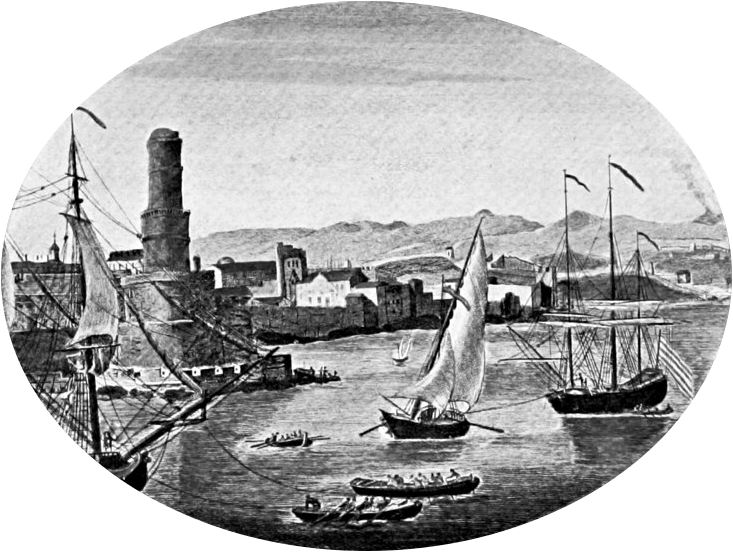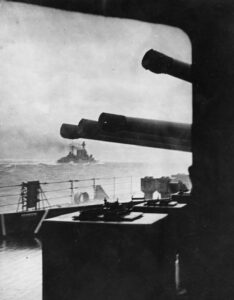Today, Port Royal, Jamaica is a small isolated fishing village with little left standing to remind any visitors of the grandeur of Port Royal’s wicked past. Frequently the subject of story tellers and movie makers, Port Royal began as a seasonal fishing camp used by natives; it then rose to become the largest and wealthiest seventeenth-century English city in the New World, only to return to its humble origins. To tell the story of Port Royal, one must talk of geology and geography, buccaneers and pirates, poor city planning, and natural disasters.
Geologically speaking, Port Royal was not a suitable place for building a city. It sits at the end of a stretch of sand and gravel known as the Palisadoes, creating a border between the Caribbean Sea and Kingston Harbor. The Palisadoes is made of sediment run-off that ended at the north side of Port Royal. An English soldier’s journal from 1655 described it as a stretch of sand barely above water, while a report from the 1670s described Port Royal as a narrow stretch of land covered with loose sand, with no grass, stones, fresh water, or trees. Modern scientists believe that most of the town sat on water-saturated sand for a depth of sixty-five feet.1 No matter how one looks at it, the ground beneath Port Royal was not ideal for a large bustling town, but that did not stop the English.
The geography of the natural harbor that would become Port Royal was ideal for many uses. The harbor was naturally wide and deep enough for large ships while providing excellent ground for anchoring.2 The area was originally used by the Taino Indians for a seasonal fishing camp, with no permanent structures. The Spanish used it as a port, but also built no permanent structures in the area. Upon taking control of Jamaica from the Spanish in 1655, the English quickly realized the potential of the harbor as a center of commerce.3

Originally known as Point Cagway, the town grew quickly. In the summer of 1655, the English began building a fort to control access to the harbor. Like most ports, the town was quickly settled by mariners, merchants, craftsmen, and prostitutes. By 1664, the town was renamed Port Royal. Expansion of the town was driven by legitimate trade with England and her colonies as well as illegal trade with Spain. Within a few years, Port Royal had grown from a seasonal fishing camp to a bustling port of trade in slaves, sugar, and raw materials vital to the English success in the Americas.4
Port Royal became a haven for buccaneers and pirates at the invitation of the various governors of Jamaica from 1660 to 1680. In an attempt to keep the Spanish from reclaiming Jamaica, the governors issued several buccaneers letters of marque, which allowed them to attack Spanish ships anywhere near Jamaica. One such buccaneer, Henry Morgan, made his home in Port Royal, eventually receiving a knighthood and holding the post of Lieutenant Governor of Jamaica. The pirates followed the buccaneers and attacked any ship deemed worthy of plundering, including English ships. This forced Jamaican authorities to outlaw piracy in 1678, arresting and executing several pirates to set an example.5 However, many pirates continued to operate out of Port Royal for many more years.6
Due to the substantial amount of citizens involved in pirate activity, Port Royal quickly earned the reputation as being the “wickedest city in the world.” It was estimated that twenty percent of the town was either brothels, gambling dens, or taverns, while fifty percent of the town was involved in piracy or privateering. However, most English sea ports outside England, Pennsylvania, and Massachusetts had a similar makeup. Even with this reputation, it was recorded in 1688 that craftsmen could make three times the wages earned in England, making such cities perfect places to begin a family.7 The citizens of Port Royal had a tolerant attitude towards diversity, religion, and lifestyle. It was a place where Quakers, Catholics, Anglicans, Presbyterians, and Jews practiced their faiths next to soldiers, pirates, and prostitutes.8

Port Royal became the largest and most affluent city in the Americas, doubling in size between 1657 and 1691.9 Although no census data exists, there were roughly 7000 to 8000 people living on the 52 acres that made Port Royal in 1692, a population density of roughly 145 people per acre.10 Due to the limited amount of available land, the growing population required residents to improvise and find space. They did this by two methods. First, officials in Port Royal granted individuals the rights to shoalwater, an area of shallow water that could be altered for development. Most of these individuals turned this shoalwater into land for building, even though it was essentially land that was part of the sea. The second method used was to simply build taller structures. Without possessing the modern knowledge of building in earthquake zones, the people of Port Royal built using brick to erect structures as high as four stories without providing a structurally sound foundation for the weight of the building. By the summer of 1692, there were approximately 2000 structures occupying Port Royal.11 Port Royal had grown too quickly to accommodate the people on the land available.
On 7 June 1692, shortly before noon, an earthquake hit Jamaica, destroying Port Royal for the first time. Throughout Jamaica, structures crumbled and people fell in the streets, but in Port Royal something very different happened. Eyewitness accounts state that buildings remained standing and people ran through the streets. Other people witnessed the streets, people, and buildings simply sink straight down into the ground.12 Some people were swallowed incompletely, remaining half above ground and trapped in the sand. There were also several witnesses that reported seeing fountains of water and sand shooting up into the sky from the ground below.13 When it was all over, two-thirds of the town was under water and roughly 2000 people had died with another 2000 dying in the immediate aftermath. The aftershocks continued daily into September.14

Initially believed to be a minor earthquake lasting only a few minutes, scientists now know this is incorrect. The geological process for what happened at Port Royal is known as liquefaction. It is a process where vibrations from an earthquake turn loose, water-saturated sand into a quicksand-like substance that can no longer support the weight of anything on the surface of the sand.15 The condition ends when the vibrations end. Liquefaction takes at least five to seven minutes to occur and requires many strong vibrations in quick succession to prevent the sand from returning to a normal state. Liquefaction also causes fountaining, or water and sand to shoot up many feet through holes in the sand. That is why scientists now believe this earthquake must have lasted at least ten to fifteen minutes and had to be of a magnitude of 8.0 or higher.16

Not wanting to give up their natural deep harbor at Port Royal, survivors decided to rebuild their town, setting up temporary housing in Kingston. However, it would seem that Port Royal was doomed to suffer. In 1703, a fire reduced most of the town to ashes. Returning to Kingston yet again, but this time bringing with them their livelihoods, residents rebuilt Port Royal a second time. The town was once again completely demolished by a major hurricane in 1722.17 Determined to remain, the town rebuilt a third time and was hit by another major hurricane in 1744. This time, very few people wanted to rebuild and the town came back with about 100 houses. Even so, the disasters kept coming. In 1770, there was a minor earthquake in Port Royal that did very little damage. This was followed by another major fire that destroyed almost the entire town in 1815. Then another massive earthquake in 1907 demolished the town, and finally a major hurricane in 1951 left only four buildings standing.18
From its beginnings as a seasonal fishing camp for the natives, Port Royal rose to become a city of great importance for England and its trade in the New World, only to be reduced to a small fishing village today. Although viewed by some as the “wickedest city in the world,” Port Royal was a city that catered to sailors and merchants, like many other port cities of the day. The stories of pirates and treasures common today harken back to a time period that lasted approximately thirty years in Port Royal. To understand the real Port Royal, one must also consider the geology and geography of the city, its buccaneers and pirates, the poor city planning, and the many natural disasters that created and destroyed Port Royal over its life.
- Matthew Mulcahy, “The Port Royal Earthquake and the world of wonders in seventeenth-century Jamaica,” Early American Studies 6, no. 2 (2008): 395-396. ↵
- Larry Gragg, “The Port Royal Earthquake,” History Today 50, no. 9 (September 2000): 29. ↵
- Matthew Mulcahy, “The Port Royal Earthquake and the world of wonders in seventeenth-century Jamaica,” Early American Studies 6, no. 2 (2008): 396-397. ↵
- Matthew Mulcahy, “The Port Royal Earthquake and the world of wonders in seventeenth-century Jamaica,” Early American Studies 6, no. 2 (2008): 397. ↵
- David Cordingly, “Pirates and Port Royal,” History Today 42, (May 1992): 62. ↵
- Larry Gragg, “The Port Royal Earthquake,” History Today 50, no. 9 (September 2000): 29. ↵
- Larry Gragg, “The Port Royal Earthquake,” History Today 50, no. 9 (September 2000): 30. ↵
- Matthew Mulcahy, “The Port Royal Earthquake and the world of wonders in seventeenth-century Jamaica,” Early American Studies 6, no. 2 (2008): 417. ↵
- “An Account of the Island of Jamaica, embellished with an elegant view of the town of Kingston, and Harbor of Port Royal,” European Magazine & London Review 2, (October 1782): 259. ↵
- Donny L. Hamilton, “Port Royal, Jamaica: Archaeological Past and Developmental Potential,” Underwater Cultural Heritage at Risk: Managing Natural and Human Impacts (2006): 49. ↵
- Matthew Mulcahy, “The Port Royal Earthquake and the world of wonders in seventeenth-century Jamaica,” Early American Studies 6, no. 2 (2008): 398-399. ↵
- M.N., letter to the editor, Gentleman’s Magazine 55, (November 1785): 879. ↵
- George R. Clark II, “Swallowed Up,” Earth 4, no. 2 (April 1995): 38. ↵
- Larry Gragg, “The Port Royal Earthquake,” History Today 50, no. 9 (September 2000): 31. ↵
- Matthew Mulcahy, “The Port Royal Earthquake and the world of wonders in seventeenth-century Jamaica,” Early American Studies 6, no. 2 (2008): 404. ↵
- George R. Clark II, “Swallowed Up,” Earth 4, no. 2 (April 1995): 41. ↵
- M.N., letter to the editor, Gentleman’s Magazine 55, (November 1785): 880. ↵
- Donny L. Hamilton, “Port Royal, Jamaica: Archaeological Past and Developmental Potential,” Underwater Cultural Heritage at Risk: Managing Natural and Human Impacts (2006): 49. ↵



85 comments
Trenton Boudreaux
A well-done article on an area of history I had never heard about. Interesting how determined the population was to return to a place that seemed doomed to suffer from disaster, though I feel that the city’s reputation as a sort of place for outcasts might have helped in that regard. Shame that it is only a small fishing village today, I feel that it would have been quite the unique place to visit at its peak.
Nathaniel Bielawski
I think that Port Royal was simply a disaster waiting to happen. Since Port Royal was located where hurricanes and earthquakes occurred, the city was doomed from the beginning. With fires plaguing the townspeople, it makes sense why most settlers left the area. Its also odd how Port Royal was initially a fishing village, rose to prominence, and declined to where it started as a fishing village.
Sara Guerrero
Wow it’s facinating to learn about the city Port Royal that was full of life just crumble over time and the supposed earthquake that destroyed homes and people were still determined to rebuild. The pirates was the most interesting and it seems like something fictional, but its amazing how they existed in real-life. Love the article and the description of this event!
Sofia Almanzan
I really enjoyed this article. We all tend to think that pirates are fictional creations that is a ride in Disneyland but it is really interesting to read about the real history of the Pirates of the Caribbean. I feel so bad for the citizens of Port Royal for having to endure all the ridiculous situations they endured.
Raul Colunga
Great article and well detailed, thanks for sharing! It is such an interesting time in history that pirates in the Caribbean were plundering ships from major nations and living without rules. It was crazy to read that Port Royal had such bad luck when it came to disasters and the fact that time after time, people had returned to rebuild their homes.
Giselle Garcia
I enjoyed reading about Port Royal, as it reminded me of the port cities depicted in pirate movies. It’s cool that this small town was a bustling port of trade for the English as well as a place for high pirate activity. It was unfortunate how Port Royal was hit with constant disasters throughout its history, but the people tried to rebuild the city anyway. It was also interesting to learn about the liquefaction that destroyed Port Royal initially.
Zachary Kobs
This was a very well written and attention-grabbing article of the city of Port Royal. It shows how quickly something great can come tumbling down. It is crazy to imagine what it must have been like to live in such a city but I feel like I would have fit in well. However, it is very unfortunate that the red flags were ignored when building the city and thousands of lives were lost because of that.
Seth Roen
Port Royal is an excellent example of the rise and fall of cities, and the saying “location, location, location,” affects a place. It is incredible how such an important city, such as a port city, was built on a weak foundation. That was noted several times by both the Spanish and the English. But being an almost perfect harbor for a trading hub, they took the risk.
Nicholas Robitille
This article was very interesting. I had never heard anything about port royale that I had not heard from the “Pirates of the Caribbean”. I had no idea that the town had such a rich history or that it was the site of such a preventable tragedy. The part on Liquefaction was truly interesting, incorporating science into history.
Makenzie Santana
This was a fascinating story about Port Royal, and all the while still sad. I’m sure there were casualties involving the many many disasters that happened within the town. I am actually surprised the English really tried to rebuild this town so many times considering that the reasons for the downfall were natural disasters. The town only lasted to be valuable for a short period time and I am sure unnecessary things were lost from the constant attempts to rebuild.